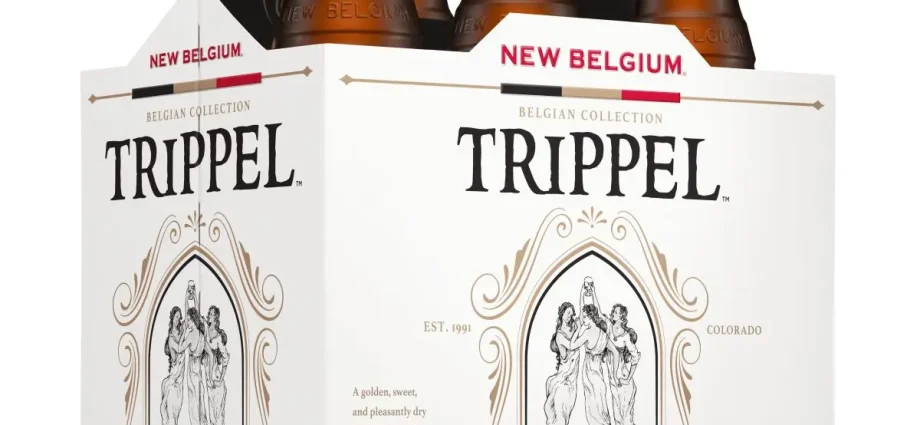Contents
Tripel – Belgian ale, first brewed in the Trappist monastery of Westmalle. Among all varieties, it turned out to be the strongest. During the production process, standard yeasts and light malts, typical for pale ales, are used.
Golden-amber color shades and a sweet fruity aroma are acquired by the addition of confectionery white sugar, hops, and sometimes spices. The method of double fermentation with after-fermentation in bottles is applied. This creates a slightly hazy color.
Bosteels, Tripel Karmeliet, 8,4%
The Bosteels Brewery dates back to 1791 and is located in Boggenhout, Belgium. This is the business of the Bosteels family. Their products are highly valued in the market for their high quality. The beer recipe has been preserved since 1679, it was invented in the Carmelite monastery in Dendermonde. The coat of arms of the Carmelites flaunts on the neck. Three types of crops are used: barley, wheat and oats.
Golden beer with a high and persistent head. The taste is soft, deep with fruity and hoppy notes. It smells of fruits, citrus, herbs and malt. Bready aftertaste with hoppy and citrus bitterness.
Lefebvre, Floreffe, 8%
Owned by the Lefebvre Company under license from the old Floreff Abbey. It has existed since 1121 near the city of Namur. The production of beer and cheese brought fame to the monasteries. A separate building was allocated for it, which was rare for this type of manufactory in Wallonia. In 1796, the abbey was robbed and ended its activities. In 1830, a small seminary was opened on its territory, but the production of products was not restarted. The rights to it were in private hands. There is a well-known fact that the monks were extremely fond of the drink. When they were late for morning mass, they were punished with a temporary deprivation of ale.
Muddy straw color with low and short-lived foam. Liquorice-caramel taste is replaced by the bitterness of hops. It smells of sweet fruit and quite a bit of citrus. The finish is long dry with notes of fruit.
Mikkeller, Triple A, 9%
Mikkeller production opened in 2008. Two years earlier, friends Mikkel and Keller had been experimenting in a kitchen in Copenhagen. It all started with copying the Danish beer Brockhouse IPA, the success of which inspired the comrades to create their own samples. In 2007, Keller left to work as an editor for the music magazine Soundvenue. Mikkel continued to brew and now works with prestigious restaurants, American distributors. Its products are sold in 40 countries. On the world market, the brewery is recognized as one of the most advanced.
An amber bittersweet tripel with delicate fruitiness. The aroma is a harmony of malt, hops, coriander and orange peel. The aftertaste is spicy and slightly bitter.
St. Bernard, Watou, 7,5%
Brewery Bernardus Watou is located in Flanders. At the beginning of the 1992th century, Catsberg Abbey was located in the village of Vatou, Belgium, and opened a cheese production, the most famous was called St. Bernardus, Watou. The production was later sold to Évariste Deconinck. The new owner bought the brewing license from the Trappist order Westvleteren. The ancient recipes of the monastery were used, as well as the exclusive yeast strain St. Sixtus. In XNUMX, the monks refused to renew the license because “Trappist” beer could not be made outside the monastery. The company became known as St. Bernardus and expanded its product line.
Dark amber, almost brown. The palate combines bread, banana and yeast tones with a hint of apricot. The aroma reveals malt.
The Trap, 7,7%
The abbey “Notre-Dame de la Grande Trappe”, located in France, gave the name of the company. In the 1884th century, the monks were persecuted and fled to the Netherlands. In XNUMX, beer brewing began on the territory of the previously founded abbey of the Monastery of the Holy Mother of God in Königshofen. The methods remain the same to this day. Until the First World War, tripel was prepared by monks for monks, but demand led to the expansion of production to an industrial scale.
The company was named Bierbrouwerij De Koningshoeven. In 1980, according to the recipes of the 1950s, La Trappe brand beer was created. Today, the company is one in seven that has the right to write “trappist” in the name of the product, because it is inextricably linked with the monks.
Golden red. Fruity with dominant malt notes and nuances of fruit, bread and hops. The tart aroma is woven from banana, citrus, spicy and bready shades.
Relevance: 16.07.2020
Tags: Beer, Cider, Ale, Types of beer










